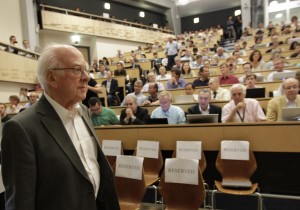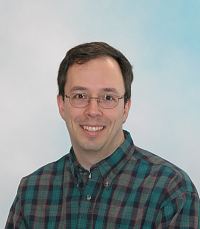
Physicist Peter Higgs arrives at a seminar, July 4, 2012 at CERN, where it was announced that a new subatomic particle, said be consistent with the long-sought Higgs boson, had been discovered. (AP)
Last summer, when scientists finally cornered the elusive building block of the universe known as the Higgs boson, they apparently also discovered something else: that the universe’s days might be numbered.
“It may be that the universe we live in is inherently unstable,” said Joseph Lykken, a theoretical physicist from the U.S. Department of Energy’s Fermi National Accelerator Laboratory. “And at some point, billions of years from now, it’s all going to get wiped out,”
Scientists refer to last year’s discovery as a Higgs boson-like particle, since they’re still working to confirm it really is the elusive particle. The Higgs boson, also called the “God particle”, is believed to give all objects mass. But Lykken says it could also spell doom for the universe.
Lykken shared his conclusions at the 2013 meeting of the American Association for the Advancement of Science. The scientist has also worked with CERN’s Large Hadron Collider (LHC), the world’s biggest and most powerful particle accelerator, which helped identify the Higgs boson-like particle.”If you use all the physics that we know now and you do what you think is a straightforward calculation, it’s bad news,” said Lykken, according to the Reuters news agency.
The calculation Lykken refers to requires knowing the mass of the Higgs to within one percent, as well as the precise mass of other related subatomic particles.
According to Lykeen if any changes are made to the parameters of the Standard Model of particle physics, even by just a little bit, that you’ll get a different end of the universe.
“This calculation tells you that many tens of billions of years from now, there’ll be a catastrophe,” Lykken told Reuters.
The Standard Model of particle physics provides an explanation for sub-nuclear physics and some aspects of cosmology in the earliest moments of the universe. In the standard model, it’s the Higgs boson that gives mass to all particles.
Lykken foresees the Armageddon scenario like this, “A little bubble of what you might think of as an ‘alternative’ universe will appear somewhere and then it will expand out and destroy us.”
He believes the cataclysmic event will take place quite quickly, at the speed of light.
The good news for planet Earth is that the end of the universe won’t occur for billions of years, long after the Sun burns out, an occurence which will destroy Earth long before the universe’s number is up.








 Science World is VOA’s on-air and online magazine covering science, health, technology and the environment.
Science World is VOA’s on-air and online magazine covering science, health, technology and the environment.